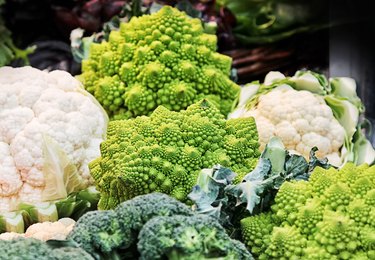
Vegetables are an important part of a healthy diet, but not all veggies pack the same nutritional punch. Cruciferous vegetables such as broccoli, cabbage and kale, tend to stand out among edible plants because they are linked to several health benefits — most notably a reduced risk of cancer.
Video of the Day
Video of the Day
What Are Cruciferous Vegetables?
Cruciferous vegetables are part of the greater Brassicaceae, or mustard family, and are alternatively referred to as Brassica vegetables. Common types include:
- Arugula
- Bok choy
- Broccoli
- Brussels sprouts
- Cabbage
- Cauliflower
- Collard greens
- Horseradish
- Kale
- Kohlrabi
- Mustard greens
- Radishes
- Rutabaga
- Turnips
- Wasabi
- Watercress
Cruciferous vegetables, or crucifers, are known for their distinctive odor and somewhat bitter flavor — two factors that make these veggies unappealing to some people. This pungency is related to their high content of sulfur-containing glucosinolates, according to the Linus Pauline Institute at Oregon State University. Ironically, these sulfur compounds are responsible for several of this vegetable group's awesome health benefits.
In fact, crucifers provide the richest sources of glucosinolates in the human diet, according to an October 2012 review in Food and Nutrition Sciences. When a cruciferous vegetable is cut, chopped or chewed, the plant enzyme myrosinase is released, which transforms the glucosinolates into other health-promoting compounds. And whenever you fork into a cooked cruciferous veggie, your intestinal bacteria help metabolize the glucosinolates.
The benefits? The breakdown products of glucosinolates, most notably indoles and isothiocyanates, may have powerful anticancer, antioxidant and anti-inflammatory properties, according to the National Cancer Institute (NCI). In fact, sulforaphane (an isothiocyanate) and indole-3-carbinol (an indole) have been widely studied for their anticancer properties.
The nutritional benefits of cruciferous vegetables extend beyond their glucosinolate content. Cruciferous vegetables are wonderful additions to your diet because they're high in fiber and are solid sources of beta-carotene (the precursor to vitamin A), B vitamins and vitamin C, says Isabel Smith, RD and founder of Isabel Smith Nutrition.
Also, cruciferous vegetables are great sources of vitamin E, vitamin K and calcium, the October 2012 review states. Another benefit: These veggies are naturally low in calories, so feel free to load up your plate!
Read more: Broccoli & Weight Loss
Cruciferous Vegetables Hold Promising Anti-Cancer Benefits
When it comes to health benefits, cruciferous vegetables may be best known for their role in reducing cancer risk. According to the Linus Pauline Institute, case-control studies (which compare historical information in study participants with a health condition to study subjects without that same diagnosis) have linked high intakes of cruciferous vegetables to a lower risk of cancer of the colon, rectum, bladder, kidney, lung, breast, ovaries, stomach, pancreas, prostate and endometrium.
Because case-control studies rely on the recollection of food intake, this research method is subject to inaccuracy and bias. This may explain why most cohort studies, where participants are followed over time with their diet routinely assessed by researchers, have found little to no association between cruciferous vegetable consumption and cancer, according to the NCI.
To better understand the link between crucifers and cancer, high quality cohort studies or randomized trials are still needed. And until more is research is conducted, it's important to note that the anticancer activity of cruciferous vegetables holds significant promise.
According to the NCI, compounds produced from glucosinolates, particularly indole-3-carbinol and sulforaphane, have the potential to prevent the mutation of healthy cells into cancer cells, and can also kill or inhibit the growth of cancer cells. Indole-3-carbinol may detoxify cancer-causing substances that enter the body, according to Smith, and substances from cruciferous vegetables can provide anti-inflammatory, antibacterial and antiviral effects — all mechanisms that may reduce cancer risk.
Cruciferous Vegetables' Heart Health Benefits
In addition to their potential role in cancer risk reduction, research is still trying to clarify how cruciferous vegetables impact heart and blood vessel disease. While eating more fruits and vegetables is known to reduce the risk of heart disease, there is very limited and sometimes conflicting observational data specific to crucifers, according to Moe Schlachter, RDN, a spokesperson for the Texas Academy of Nutrition and Dietetics and president of Houston Family Nutrition.
For example, consuming high amounts of cruciferous veggies has been shown to reduce the risk of heart disease, a June 2017 research analysis published in the International Journal of Epidemiology concluded. Meanwhile, a study of older Australian women published in the April 2018 issue of Journal of the American Heart Association linked a higher intake of cruciferous vegetables to a reduced thickness of the carotid artery wall — suggesting that crucifers may protect the blood vessels. What's more, the sulforaphane in these veggies has been linked to a reduced risk of heart disease, a January 2015 study in Oxidative Medicine and Cellular Longevity found.
In contrast, crucifers were not found to be protective against heart disease in the Nurses' Health Study and the Health Professionals Follow-Up Study, according to a report in the June 2018 issue of Clinical Epidemiology.
Crucifers appear to have the right mix of components to promote heart health since they are rich in substances that may decrease the risk of heart attack and stroke. According to Schlachter, preliminary studies have associated high amounts of glucosinolate from broccoli with lower LDL cholesterol levels while sulforaphane has been shown to reduce oxidative stress — which plays a large role in the development of many cardiac-related dysfunctions. But additional studies are needed to better understand the role of crucifers in cardiovascular health.
Other Health Benefits of Cruciferous Vegetables
In addition to their potential anticancer and heart-protective properties, cruciferous vegetables may provide additional health benefits, according to a 2018 review in the Journal of Human Health Research.
Compounds found in these vegetables have the potential to improve blood sugar and treat type 2 diabetes as well as treat H. pylori infections, a bacteria that leads to stomach ulcers. However, as you've likely guessed, the research is preliminary and more quality studies are needed to clarify these benefits.
One of the compounds formed from glucosinolates — 3,3′-diindolylmethane (DIM) — is recognized for its hormone-balancing benefits in addition to its more established anticancer, antioxidant and detoxification properties. DIM is touted to prevent problems related to excess estrogen (such as hormone-fueled breast cancer) or excess testosterone (including hormonal acne).
However, because the transformation of glucosinolates to DIM in the body can be unpredictable, research of this compound is limited to supplements, not cruciferous vegetables. Plus, there aren't many human studies on this compound.
Warning
Since DIM may not be appropriate for everyone to take, you should note that supplements should not be taken without a doctor's assessment and approval, the National Institutes of Health recommends.
Are There Any Risks Associated With Eating Cruciferous Vegetables?
Now that you know about the plethora of potential health benefits crucifers are linked to, it's time to brush up on the possible risks of eating too much of these.
Very high intake of cruciferous vegetables has caused hypothyroidism in animal research. A plausible explanation is that some of the compounds created from crucifers can interfere with thyroid hormone production, and others may compete with the thyroid gland's uptake of iodine, a nutrient important for thyroid health. Although eating cruciferous vegetables consumption isn't directly linked to thyroid problems in humans, more research is needed on this issue as well.
How to Eat Cruciferous Veggies

Although it's good to emphasize cruciferous vegetables in your diet, you may not need to eat large, daily portions to reap the health benefits. The U.S. Dietary Guidelines recommend at least 2.5 cups of vegetables daily, with this same amount weekly from dark green and cruciferous choices. So, aiming to eat at least a half cup of cruciferous veggies most days of the week is a good place to start!
What's more, it's important to understand how different types of cooking methods affect your veggies' health benefits. Bioavailability of glucosinolates and their breakdown products is affected by your cooking temperature and method, and more research is needed to understand ways to optimize the availability of these health-promoting substances, according to a July 2017 report in the Journal of Food Composition and Analysis.
"Boiling is not the best option for cooking cruciferous vegetables because glucosinolates are water-soluble and may be lost in the cooking water," Schlachter tells us. Additionally, high heat may deactivate myrosinase and decrease the bioavailability of sulforaphane.
So how should you cook your crucifers? "Our best cooking methods generally involve using less water and low heat," Schlachter says. "So that means steaming, stir-frying or even microwaving."
If you find crucifers unappealing, the variety of choices along with creative preparation strategies may eventually win you over. Here are some tips to make cruciferous vegetables tasty and appealing:
- Add mustard greens, arugula, radishes, cabbage or kale to your usual lettuce salads.
- Use bok choy, broccoli or cabbage in your favorite stir-fry.
- Roast broccoli, cauliflower, kohlrabi, turnips or Brussels sprouts by drizzling with olive oil, seasoning as desired, and placing in an oven set to 400° Fahrenheit for about 25 minutes, tossing halfway through. Roasting crucifers helps bring out their natural sweetness!
- Add chopped kale to smoothies.
- Finely dice cauliflower and use as an alternative to rice.
- Use cauliflower crust in homemade pizza.
- Serve broccoli, cauliflower, radishes and kohlrabi raw as appetizers or snacks.
Warning
If you have special dietary needs and have been told to limit cruciferous vegetables because of their fiber or vitamin K content, speak with your doctor or dietitian before adding them to your diet. Also, if you have hypothyroidism or are concerned they may worsen your Irritable Bowel Syndrome (IBS) symptoms, consult your doctor.
- Oregon State University: Linus Pauline Institute: "Cruciferous Vegetables"
- Food and Nutrition Sciences: "Nutritional Quality and Health Benefits of Vegetables: A Review"
- National Cancer Institute: "Cruciferous Vegetables and Cancer Prevention"
- International Journal of Epidemiology: "Fruit and Vegetable Intake and the Risk of Cardiovascular Disease, Total Cancer and All-Cause Mortality—A Systematic Review and Dose-Response Meta-Analysis of Prospective Studies"
- Clinical Epidemiology: "Intake of Glucosinolates and Risk of Coronary Heart Disease in Three Large Prospective Cohorts of US Men and Women"
- Journal of the American Heart Association: "Cruciferous and Total Vegetable Intakes Are Inversely Associated With Subclinical Atherosclerosis in Older Adult Women"
- Oxidative Medicine and Cellular Longevity: "Sulforaphane Protects against Cardiovascular Disease via Nrf2 Activation"
- Molecular Nutrition and Food Research: "Diet Rich in High Glucoraphanin Broccoli Reduces Plasma LDL Cholesterol: Evidence From Randomised Controlled Trials"
- Journal of Human Health Research: "The Benefits of Brassica Vegetables on Human Health"
- National Institutes of Health: "Dietary Supplements: What You Need to Know"
- Journal of Food Composition and Analysis: "Challenges of developing a valid dietary glucosinolate database"
- Dietary Guidelines 2015-2020: "Key Elements of Healthy Eating Patterns"
- National Institutes of Health Office of Dietary Supplements: "Dietary Supplements: What You Need to Know"